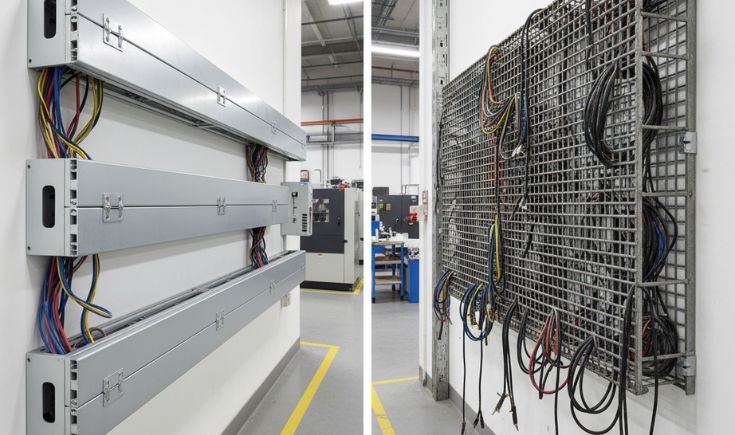Raceways vs. Traditional Cable Trays: The Next Evolution in Cable Routing

28 September 2025 || By: Admin
Introduction
In modern electrical installations, efficient cable management is vital for safety, performance, and aesthetics. For decades, cable trays have been the go-to solution for routing power and communication cables. But with advances in building design and stricter regulations, raceways have emerged as a superior alternative in many applications.
As a leader in electrical solutions, Hutaib Electricals explores how raceways compare to traditional cable trays and why they’re shaping the next evolution in cable routing.
Understanding Cable Trays
Cable trays are open or semi-enclosed support systems designed to hold and route cables along walls, ceilings, or under floors. They’re typically made from steel, aluminum, or fiberglass and include several types:
- Ladder cable trays
- Perforated cable trays
- Wire mesh trays
- Solid-bottom trays
Benefits of Cable Trays:
- Easy to install and inspect
- Cost-effective for large cable runs
- Good ventilation for power cables
However, their open design can expose cables to dust, moisture, and accidental damage, which is increasingly a concern in modern facilities.
What Are Raceways?
Raceways are enclosed conduit-like pathways that protect and route electrical wiring. They’re available in materials like PVC, metal, and fiber-reinforced plastics, and come in various forms:
- Surface raceways
- Underground raceways
- Flexible raceways
- Modular raceways
Benefits of Raceways:
- Complete physical protection for cables
- Neater, more aesthetic installations
- Better compliance with fire and safety codes
- Reduced electromagnetic interference (EMI)
Key Differences: Raceways vs. Traditional Cable Trays
| Feature | Raceways | Cable Trays |
|---|---|---|
| Protection | Fully enclosed, higher cable safety | Open or semi-open, vulnerable to dust/moisture |
| Aesthetics | Clean and modern appearance | Industrial look |
| Compliance | Easier to meet stringent building codes | May require extra protection for compliance |
| Flexibility | Modular options allow easy re-routing | Good for large, static cable runs |
| Cost | Slightly higher upfront cost but long-term savings | Lower initial cost, may require more maintenance |
Why Raceways Are the Next Evolution in Cable Routing
- Enhanced Safety: Enclosed systems minimize the risk of fire hazards, short circuits, and accidental damage — key for data centers, hospitals, and commercial spaces.
- Future-Proofing: Modular raceways make it easy to upgrade or re-route cables as technology evolves, saving time and labor costs.
- Improved Aesthetics: In modern office spaces, schools, and retail environments, concealed raceways create a polished, clutter-free look.
- Compliance with Modern Standards: As fire, electrical, and EMI regulations become stricter, raceways provide better compliance compared to open cable trays.
Choosing Between Raceways and Cable Trays
When deciding between raceways and traditional cable trays, consider:
- Location: Indoor, outdoor, or underground
- Cable Volume: Large bundles vs. small, organized runs
- Aesthetic Needs: Public-facing spaces benefit from enclosed raceways
- Regulatory Requirements: Fire safety, EMI protection, and local codes
Conclusion
Raceways represent the next evolution in cable routing, offering enhanced protection, improved aesthetics, and better compliance compared to traditional cable trays. Partnering with Hutaib Electricals ensures you get the right solution for your project combining innovation, quality, and value.